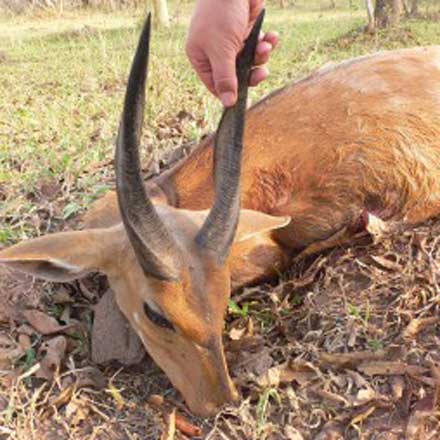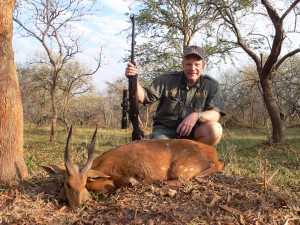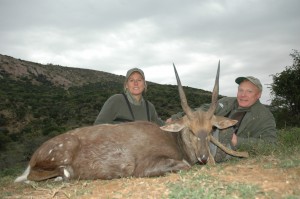
Okay, so I didn’t really know what a “bushbuck” was the first time I went to Africa. Most hunters probably don’t. Obviously it’s some kind of buck that lives in thick bush, right?
The bushbuck, Tragelaphus scriptus, is actually the smallest member of the group of spiral-horned antelope, and is very possibly the most widespread of all of Africa’s
antelope. You’ll find bushbuck somewhere in the fine print of the game list in almost every hunting area in Africa, unless it’s just plain too dry. The bushbuck loves heavy
riverine cover, and with the exception of arid countries like Namibia and Botswana, found from South Africa to Ethiopia, and from Tanzania to West Africa. In this regard,
the bushbuck is very much “Africa’s whitetail,” found in suitable habitat almost everywhere.
Although he is closely related, the bushbuck is not as dramatically impressive as a greater kudu or as awesome as an eland. He will probably not be high on your safari wish list…at least not for a while. Hunting bushbuck is sort of an acquired taste, but it’s a whole lot easier if you acquire it early in your African hunting career.
You see, there are two primary ways to take a bushbuck. The first is in the chance encounter. This is a poor way to take any great trophy, but while you’re knocking about in thick cover, you are always likely to bump into a great bushbuck. If you haven’t yet come to appreciate this classy little antelope, it’s all too easy to say, “No thanks, let’s keep looking for kudu, or warthog, or whatever.” This would probably be a mistake. When Lady Luck smiles, one shouldn’t kick sand in her face, because she is very likely to retaliate.
The retaliation may come during the second and most common way to take a bushbuck- hunting for him carefully and specifically. This is also a lot like hunting whitetail. You can, in fact, hunt bushbuck by “stand hunting.” The small, pixie-like tracks tell you there’s a concentration, so you find a good spot where you can watch the clearings on a brushy hillside, and you wait mornings and evenings for a bushbuck to show himself.
Or, as with whitetails, you can still-hunt along the edges or in the thick stuff. How thick it is determines your chances. The most likely thing that will happen is you’ll hear bushbuck giving their sharp alarm bark as they move away from you—just like a whitetail blowing in alarm. The only advantage you have is...
that the African bushbuck, at least in well-managed areas, usually isn’t as hunter-educated as the good old American whitetail, so your chances are a wee bit better, but never certain.

This is generally still not the primary goal or activity of a safari, but the wonderful thing about bushbuck is they are widespread enough that bushbuck country is usually close at hand, and you can always try. So, if you get back to camp in mid-afternoon and perhaps it’s too late to try to find buffalo spoor, you can always take an afternoon walk, and look for bushbuck. Try it a few times, and you’ll surely get hooked! Some of my most memorable African hunts over the last 35 years have been for bushbuck in the bamboo forests of Mount Kenya, heavy riverine along the Sabi, Limpopo, Chinko, Zambezi, Luangwa, and a dozen other rivers,in the high country of Ethiopia, and so many other places.
So why would anyone wish to hunt bushbuck so many times? Heck, that’s easy, and there are two answers. First, just like our ten million whitetail hunters, the bushbuck isn’t an animal one tires of hunting. There are lots of them, and licenses and trophy fees are generally low. Second, and perhaps even more important, there are lots of different bushbuck! Just like our whitetail, the bushbuck is found in dozens of argued and arguable subspecies with size and color varying considerably.
The biologists will never agree on how many races and subspecies there really are, but we, as hunters, generally group the bushbuck into eight more or less regional categories: Cape bushbuck, in southern South Africa; Limpopo bushbuck, in the Limpopo drainage; Chobe, in the Zambezi and Chobe drainages; East African, in Tanzania; Nile, in the drainages of the Nile; and harnessed bushbuck in Central and West Africa. The other two are Abyssinian and Menelik’s bushbuck, both found in Ethiopia. This is a bit of an anomaly, but the Abyssinian bushbuck is red and found in low country, while the Menelik’s is very black and found only in the high country. Come to think of it, there are other anomalies. The Cape bushbuck, the farthest south, can be just as black as the Menelik’s, the farthest north. The...
harnessed bushbuck, the westernmost race, is said to be the most colorful, with a lovely pattern of stripes and spots on an orange background, but the Chobe bushbuck in eastern Mozambique, probably the easternmost of all bushbuck, are also very brightly colored.

That’s all fine with me. I don’t make the rules or draw the lines, and the bushbuck is definitely one of my favorite African antelope. Just recently, after being closed for more than 30 years, I had the chance to hunt Nile bushbuck in Uganda. No, I’m not yet so far gone that this was the sole objective of the trip, but the Nile bushbuck was certainly one of the more important animals. We found them plentiful along the Kafu River, perhaps the calmest bushbuck I have ever seen, and I took a very nice ram.
Which leaves just one, the Abyssinian bushbuck. I’m still not so far gone that I’d go to Ethiopia for a bushbuck, even the last one—but if I ever get back to that country,Abyssinian bushbuck would be high on my list. But the point isn’t trying to collect all the bushbucks any more than North American hunters try to collect all the races of whitetail (Good Grief!). The point is that the bushbuck is a classy little antelope that’s a lot of fun to hunt. If he’s in the area you’re hunting, spend some time with him. You’ll probably get hooked.